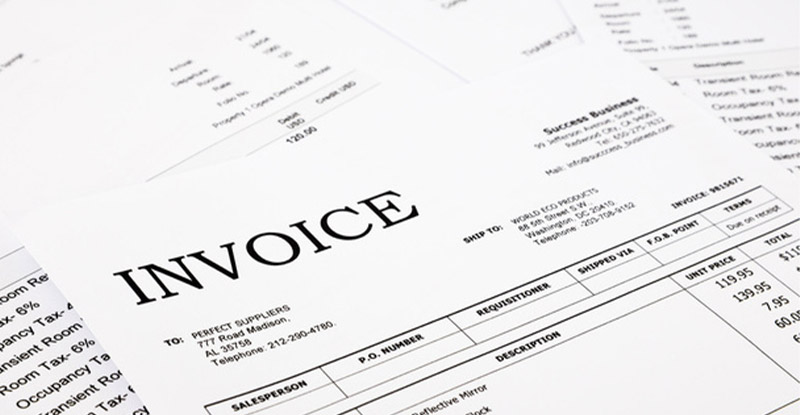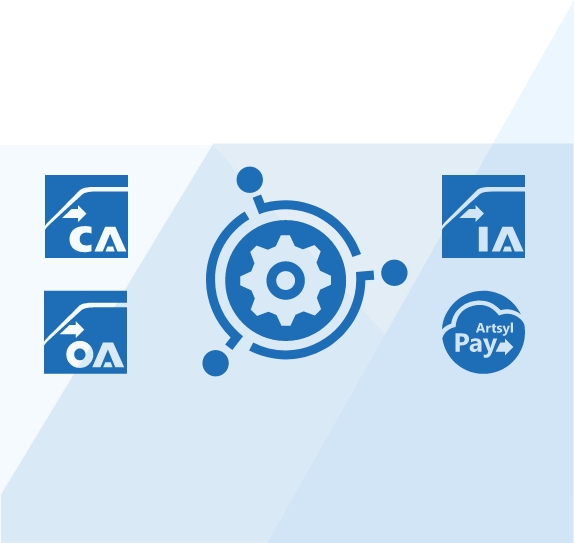What is an interim invoice? As a business owner, cash flow management is vital to the success of your business. You need to ensure that you are paid on time for your services to maintain a positive cash flow. This is where interim invoices come in handy.
In essence, an interim invoice is a payment request that asks for a partial payment for work that has been done so far. In this blog post, we will help you understand what interim invoices are and how to use interim invoices effectively to improve your cash flow management.

Navigating the sea of interim invoices?
Dive into the revolutionary world of InvoiceAction and watch as we transform your interim invoice management into a breeze. Wave goodbye to hassles and welcome streamlined efficiency.
Interim Invoice: The Definition
An interim invoice is a bill that a service provider issues to a client before completing the project. It covers a portion of the total project cost, based on the work that has been completed so far. By issuing interim invoices, you ensure that you get paid regularly throughout the project, which is beneficial for cash flow.
Interim invoices can be issued as frequently as needed, according to the terms agreed upon in the initial contract.
Invoice Automation Software
Related Videos
Interim Invoice: The Business Purposes
If you are working on a long-term project that is expected to take a considerable amount of time, using interim invoices is an excellent way to manage your cash flow. It allows you to get paid for work done instead of waiting until the end of the project. Interim invoices are also useful when multiple tasks are involved in the project, and you have completed the first portion of the job.
Juggling multiple projects and their interim billing?
It’s time to elevate your game! With docAlpha, unlock a suite of features designed to optimize and simplify interim invoice management. Because your business deserves nothing but the best
Book a demo now
Benefits of Interim Invoices
Interim invoices offer various benefits to businesses, clients, and the flow of projects. Here are some of the primary advantages.
Improve Cash Flow with Interim Invoices
For businesses, especially those in industries where projects can span several months or even years, waiting for project completion to invoice can strain finances. Interim invoicing ensures a consistent and predictable flow of revenue, helping to maintain operational liquidity.
Interim Invoices Help Spread Financial Burden
Clients often appreciate interim invoices as they spread out the financial burden over the duration of the project. This setup can make budgeting easier, as clients can allocate funds in installments rather than making a significant lump sum payment at the end.
Interim Invoices Monitor Project Progress
Interim invoices can serve as progress reports. They often detail the stages of work completed, allowing both the provider and the client to track the progress of a project against the timeline and budget.
Ready to supercharge your interim invoicing process? OrderAction brings the power of automation, accuracy, and agility to your fingertips when managing sales orders. Join countless businesses redefining their invoice and order management landscape.
Book a demo now
Interim Invoice Motivates the Timely Work Completion
Knowing that there will be regular invoicing can encourage service providers to meet milestones on time, ensuring that they can bill for the next phase of work.
Easier Dispute Resolution with Interim Invoices
If there are any disagreements or concerns about the work or the amount billed, it’s often easier to address these issues in smaller chunks. Interim invoicing allows for periodic reviews and adjustments, if necessary.
Flexibility in Contractual Terms
Both parties can negotiate terms more flexibly, adjusting for any unforeseen circumstances or changes in the project scope. This adaptability can lead to better relationships and smoother project execution.
Reduced Financial Risk with Interim Invoices
In cases where the client’s financial situation changes or if they become insolvent, having received partial payments via interim invoices reduces the service provider’s exposure to bad debts.
Fosters Trust with Interim Invoices
Regular, transparent invoicing can foster trust between businesses and their clients. When clients see regular updates on what they’re paying for, it can boost their confidence in the service provider’s reliability and professionalism.
Interim Invoice Improves Administrative Efficiency
For longer projects, interim invoices can help both parties maintain better financial records, making it easier to reconcile accounts and manage budgets.
Early Detection of Budget Overruns
If a project is going over budget, interim invoices can serve as early warning signals, prompting discussions and adjustments before costs spiral out of control.
In summary, interim invoicing is a strategic approach that can enhance financial stability, foster better client relationships, and ensure smoother project management and execution.
Ever dreamt of an assistant that makes interim invoicing feel like a walk in the park? Dream no more! docAlpha is here to redefine the way you manage, track, and process interim bills.
Book a demo now
How to Create Interim Invoice
Creating interim invoices is a practice often used in long-term projects or when dealing with high-value transactions. Interim invoices break down the total cost into smaller, manageable payments. This can improve cash flow for the service provider and make budgeting easier for the client. Here’s how to create interim invoices effectively:
Step 1: Define Billing Milestones
In the initial contract or agreement, clearly outline billing milestones that warrant an interim invoice. These could be project phases, specific deliverables, or set time periods. Make sure both parties understand and agree on these milestones.
Step 2: Decide on the Percentage or Amount
Determine what percentage of the total project cost will be billed at each milestone. Alternatively, specify a fixed amount for each interim invoice. Make sure this is also clearly stipulated in the contract.
Step 3: Include All Essential Details
When you create interim invoice, make sure it contains all the essential elements of a standard invoice, such as:
- Business and client contact details
- Invoice number (unique for each invoice)
- Invoice date
- Detailed description of the work completed or milestones reached
- Itemized list of services rendered or products supplied
- Due date for payment
Step 4: Specify it’s an Interim Invoice
Clearly mark the document as an ‘Interim Invoice.’ This helps to differentiate it from final invoices and prevents any confusion.
Step 5: Include Cumulative Information
For transparency, include information about the total project cost, how much has been invoiced to date, and how much is still outstanding. This keeps both parties aligned on the financial aspects of the project.
Step 6: Reference Previous Payments
If applicable, mention any payments already received and how they relate to the current interim invoice.
Step 7: Send the Invoice
Once the invoice is prepared, send it to the client via the agreed-upon method, whether that be email, post, or using invoicing software such as InvoiceAction.
Step 8: Track and Follow-Up
Keep a record of all interim invoices sent, and make sure to follow up if the payment due date approaches and payment has not been received.
Step 9: Reconcile with the Final Invoice
When the project is completed, create a final invoice that accounts for all interim invoices, any remaining balances, and additional costs or discounts that were not previously invoiced. Make sure the final invoice references all interim invoices for clarity.
Step 10: Maintain Records
Maintain a comprehensive record of all interim invoices for accounting purposes and for potential future reference in case of disputes.
By following these steps, you can create interim invoices that are clear, comprehensive, and agreed-upon by both parties, thus facilitating smoother financial transactions and healthier cash flow.
When Should You Use an Interim Invoice?
When preparing an interim invoice, make sure to indicate the percentage of the total project cost that is being invoiced, the payment due date, and any other relevant terms and conditions that need to be met before the payment is made.
Remember that the interim invoice is not a final bill, and it should be considered a partial payment. Ensure that you use a professional invoice template and include all the necessary billing information.
What’s the Difference Between Interim Invoices and Regular Invoices?
Interim invoices and regular invoices serve similar purposes in that they both request payment for goods or services. However, they differ primarily in terms of the scope and timing of the billing.
Scope of Work or Service
- Interim Invoice: This type of invoice is issued for a portion or phase of the total work or service provided. For long-term projects or contracts, interim invoices are used to bill for work that has been completed during a specific period.
- Regular Invoice: This is typically issued once a job is complete or a product has been delivered. It encompasses the total amount due for the entire scope of work or service rendered.
Timing
- Interim Invoice: Issued periodically over the course of a project. For example, in a year-long project, interim invoices might be sent monthly or at the end of specific project milestones.
- Regular Invoice: Sent after the completion of a job or delivery of a product, or as per the agreed billing cycle with the client (e.g., monthly for ongoing services).
Purpose of Invoices
- Interim Invoice: Helps with cash flow for businesses, ensuring that they receive regular payments for ongoing projects, rather than waiting until the very end. It also spreads out the financial responsibility for the client, allowing them to budget for smaller, periodic payments.
- Regular Invoice: Provides a single, comprehensive bill for the client once the agreed-upon job is complete or product delivered.
Struggling with keeping tabs on all your interim invoices? Let OrderAction light the way! Harness the best in technology and innovation for seamless invoice and order management. Step into the future — it’s one click away.
Book a demo now
Detailing of Invoices
- Interim Invoice: Contains specific details about the portion of the work that’s been completed during the invoiced period, and may also include cumulative totals from previous interim invoices.
- Regular Invoice: Contains a detailed account of the entire job or the products delivered, encompassing all charges, deductions, and net amounts due.
In essence, while both types of invoices are tools for businesses to request payment, interim invoices are more about maintaining cash flow and managing long-term projects, whereas regular invoices are about finalizing transactions and billing for completed work.
Pros and Cons of Using Interim Invoices
One of the significant advantages of interim invoices is that they help improve cash flow management, which is essential for long-term business success. By requesting partial payments throughout the project, you can maintain a steady stream of income.
Interim invoices also help to establish trust between the service provider and client, as it shows that you are committed to the project. The disadvantage, however, is that it can be a bit confusing to clients who are used to making payments in full. It is, therefore, essential to ensure that you communicate the billing process to your clients before starting the project.
Interim Invoice Best Practices
When using interim invoices, it is important to set clear expectations with your clients. You should provide a detailed breakdown of the project deliverables, payment schedule, and expectations for the project’s delivery.
Regular communication is also key to ensure that clients are informed about the project’s progress and aware of any change orders or scope creep. It is also important to use professional invoicing software that helps to automate invoicing processes and make it easier to track payments.
Final Thoughts: Interim Invoices Benefits in Business
Interim invoices are an effective way to manage your cash flow and maintain a steady stream of income throughout the project. However, it is essential to communicate the billing process to your clients before starting the project and outline all the expectations to avoid misunderstandings.
By following the best practices outlined in this article, you can improve the client experience, establish trust, and ultimately improve your business’s performance.
Crafting and managing interim invoices shouldn’t be a chore. Discover the docAlpha difference and equip your business with a toolkit designed for excellence in interim invoice management. Because you deserve an invoicing process as dynamic as your projects.
Book a demo now
FAQ about Interim Invoices
What is an interim invoice?
An interim invoice is a type of billing mechanism where the supplier charges the client for a portion of the work completed during a specified period, rather than waiting for the entire project or job to be finished.
When are interim invoices typically used?
Interim invoices are often used in long-term projects or contracts, ensuring that suppliers receive periodic payments for the work they’ve completed rather than waiting for the end of the project.
How do interim invoices differ from regular invoices?
While regular invoices bill for a completed job or delivered product, interim invoices charge for a fraction or phase of the job.
Are interim invoices legally binding?
Yes, like other invoices, they serve as a contractual demand for payment and can be used as a basis for legal action if not paid.
What details should an interim invoice include?
They should have detailed descriptions of the work completed, the period covered, the agreed-upon rate or price, any taxes or additional fees, the total amount due, and payment terms.
Why are interim invoices beneficial?
They help with cash flow, ensuring that suppliers have a steady income during the duration of a lengthy project. It also spreads out the financial burden on the client over multiple payments.
Do all businesses use interim invoices?
Not all businesses use them. Their usage is more prevalent in industries where projects are lengthy, like construction, consultancy, or custom manufacturing.
How are the amounts on interim invoices determined?
It’s often based on the percentage of project completion or as per pre-decided milestones in a project.
Is there a final invoice after interim invoices?
Yes, once the entire project is complete, a final invoice is typically sent, detailing all interim billings and any remaining balance that’s due.
What if there’s a dispute over an interim invoice?
Like any invoice dispute, it’s best first to communicate with the other party to resolve any misunderstandings. If an agreement can’t be reached, it may be necessary to seek mediation or legal counsel.


 Self-Billing Invoice: What Is It?
Self-Billing Invoice: What Is It? Supplier Invoice Management Software
Supplier Invoice Management Software How to Build an Automated Invoice Processing Workflow
How to Build an Automated Invoice Processing Workflow Invoice vs. a Quotation - What’s the Difference?
Invoice vs. a Quotation - What’s the Difference? What is Invoice Factoring?
What is Invoice Factoring? What Are Invoice Approvals?
What Are Invoice Approvals?
